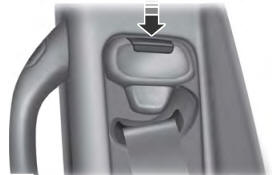Ford Explorer: Side and Rear Vision / Description and Operation - Blind Spot Information System - Overview
BLIS®
The BLIS® aids the driver in assessing whether another vehicle is present within a specific area (blind spot) to either side of the vehicle, extending rearward approximately 6 m (20 ft) beyond the rear bumper while driving on roads and highways. The system is not designed to prevent contact with other vehicles or objects. The BLIS® uses the exterior mirror BLIS® Light Emitting Diodes (LEDs) to alert the driver that a vehicle has been detected. The BLIS® provides alerts when the vehicle is in forward gear and the vehicle speed is greater than 10 km/h (6 mph).
CTA
When the vehicle is in REVERSE (R), the CTA system alerts the driver of vehicles that are approaching from the side when backing out of a front-in parking space or backing towards the road. The system can detect a vehicle approaching from 14 m (45 ft) away at a speed up to 64 km/h (40 mph) from the left or right side of the vehicle. The CTA system uses the exterior mirror BLIS® Light Emitting Diodes (LEDs), a warning chime from the audio speakers and a message in the IPC message center to notify the driver of approaching vehicles.
NOTE: If a MyKey® restricted key is in use, the BLIS® and CTA system cannot be turned off in the IPC.
NOTE: If the vehicle is towing a trailer the BLIS® or CTA system may detect the trailer and cause a false alert.
Reverse Brake Assist
The reverse brake assist is a software feature that provides automatic coarse (harsh) braking for detected obstacles behind a vehicle if audible and visual alerts are not heeded by the driver. The reverse brake assist is a software feature that utilizes the rear parking aid system, rear parking aid camera, BLIS and ABS to reduce the impact damage or assist in avoiding a collision. When the vehicle is in reverse traveling at a speed above 1 mph (1.5 km/h) and below 7 mph (12 km/h), if the systems detects an obstacle behind the vehicle, the vehicle is brought to a stop at a safe distance from the obstacle. The brakes are only held for a short period of time allowing the driver to take control. Upon braking, a warning graphic is displayed on the center stack FDIM and a notification appears in the IPC message center. These graphics are displayed momentarily.
For more information on the reverse brake assist feature, refer to the owners literature.
 Description and Operation - Blind Spot Information System - System Operation and Component Description
Description and Operation - Blind Spot Information System - System Operation and Component Description
System Operation
BLIS® and CTA
System Diagram
Item
Description
1
GWM
2
SCCM
3
HS-CAN1
4
HS-CAN2
5
HS-CAN3
6
IPC
..
Other information:
Ford Explorer 2020-2026 Owners Manual: Creating a Wi-Fi Hotspot
You can create a Wi-Fi hotspot in your vehicle and allow devices to connect to it for access to the Internet. Press the button to enter the settings menu. Select Connectivity Features. Select Vehicle Hotspot.Note: The vehicle hotspot default setting is on...
Ford Explorer 2020-2026 Service Manual: Description and Operation - Lane Keeping System - Overview
Overview The Lane Keeping System (LKS) has 2 functions, lane keeping aid and lane keeping alert. The Lane Keeping System (LKS) utilizes the camera located in the IPMA to detect and track the road lane markings. The lane keeping alert detects unintentional drifting toward the outside of the lane and alerts the driver through steering wheel vibrations and a visual alert in the IPC message ce..
Categories
- Manuals Home
- 6th Generation Explorer Owners Manual
- 6th Generation Explorer Service Manual
- Engine - 2.3L EcoBoost (201kW/273PS)
- Traction Control
- Driveline
- New on site
- Most important about car
Seatbelt Height Adjustment
WARNING: Position the seatbelt height adjuster so that the seatbelt rests across the middle of your shoulder. Failure to adjust the seatbelt correctly could reduce its effectiveness and increase the risk of injury in a crash.


